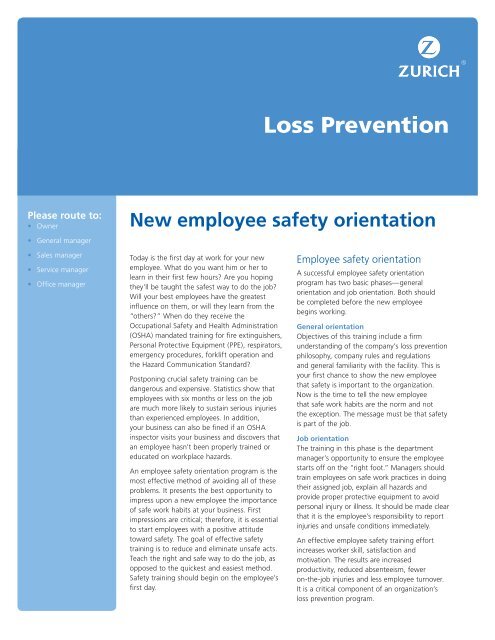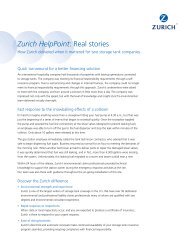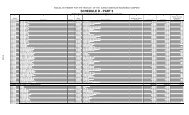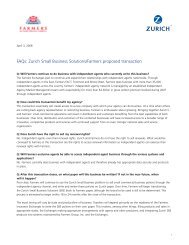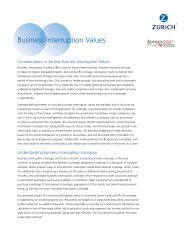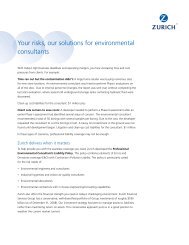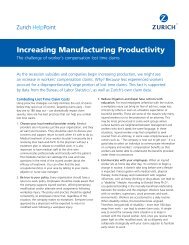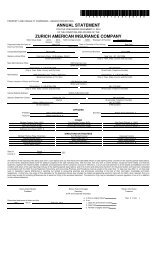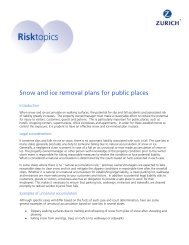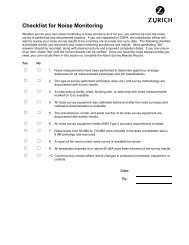New employee safety orientation
New employee safety orientation
New employee safety orientation
Create successful ePaper yourself
Turn your PDF publications into a flip-book with our unique Google optimized e-Paper software.
Loss Prevention<br />
Please route to:<br />
• Owner<br />
• General manager<br />
<strong>New</strong> <strong>employee</strong> <strong>safety</strong> <strong>orientation</strong><br />
• Sales manager<br />
• Service manager<br />
• Office manager<br />
Today is the first day at work for your new<br />
<strong>employee</strong>. What do you want him or her to<br />
learn in their first few hours Are you hoping<br />
they’ll be taught the safest way to do the job<br />
Will your best <strong>employee</strong>s have the greatest<br />
influence on them, or will they learn from the<br />
“others” When do they receive the<br />
Occupational Safety and Health Administration<br />
(OSHA) mandated training for fire extinguishers,<br />
Personal Protective Equipment (PPE), respirators,<br />
emergency procedures, forklift operation and<br />
the Hazard Communication Standard<br />
Postponing crucial <strong>safety</strong> training can be<br />
dangerous and expensive. Statistics show that<br />
<strong>employee</strong>s with six months or less on the job<br />
are much more likely to sustain serious injuries<br />
than experienced <strong>employee</strong>s. In addition,<br />
your business can also be fined if an OSHA<br />
inspector visits your business and discovers that<br />
an <strong>employee</strong> hasn’t been properly trained or<br />
educated on workplace hazards.<br />
An <strong>employee</strong> <strong>safety</strong> <strong>orientation</strong> program is the<br />
most effective method of avoiding all of these<br />
problems. It presents the best opportunity to<br />
impress upon a new <strong>employee</strong> the importance<br />
of safe work habits at your business. First<br />
impressions are critical; therefore, it is essential<br />
to start <strong>employee</strong>s with a positive attitude<br />
toward <strong>safety</strong>. The goal of effective <strong>safety</strong><br />
training is to reduce and eliminate unsafe acts.<br />
Teach the right and safe way to do the job, as<br />
opposed to the quickest and easiest method.<br />
Safety training should begin on the <strong>employee</strong>’s<br />
first day.<br />
Employee <strong>safety</strong> <strong>orientation</strong><br />
A successful <strong>employee</strong> <strong>safety</strong> <strong>orientation</strong><br />
program has two basic phases—general<br />
<strong>orientation</strong> and job <strong>orientation</strong>. Both should<br />
be completed before the new <strong>employee</strong><br />
begins working.<br />
General <strong>orientation</strong><br />
Objectives of this training include a firm<br />
understanding of the company’s loss prevention<br />
philosophy, company rules and regulations<br />
and general familiarity with the facility. This is<br />
your first chance to show the new <strong>employee</strong><br />
that <strong>safety</strong> is important to the organization.<br />
Now is the time to tell the new <strong>employee</strong><br />
that safe work habits are the norm and not<br />
the exception. The message must be that <strong>safety</strong><br />
is part of the job.<br />
Job <strong>orientation</strong><br />
The training in this phase is the department<br />
manager’s opportunity to ensure the <strong>employee</strong><br />
starts off on the “right foot.” Managers should<br />
train <strong>employee</strong>s on safe work practices in doing<br />
their assigned job, explain all hazards and<br />
provide proper protective equipment to avoid<br />
personal injury or illness. It should be made clear<br />
that it is the <strong>employee</strong>’s responsibility to report<br />
injuries and unsafe conditions immediately.<br />
An effective <strong>employee</strong> <strong>safety</strong> training effort<br />
increases worker skill, satisfaction and<br />
motivation. The results are increased<br />
productivity, reduced absenteeism, fewer<br />
on-the-job injuries and less <strong>employee</strong> turnover.<br />
It is a critical component of an organization’s<br />
loss prevention program.
As an aid to ensure that all appropriate information has been presented to the <strong>employee</strong>, an<br />
<strong>employee</strong> <strong>orientation</strong> checklist should be used and signed by the <strong>employee</strong>. This checklist should be<br />
maintained in <strong>employee</strong> personnel files. Some suggested topics for the checklist include:<br />
l Discuss company loss prevention policy and<br />
<strong>safety</strong> regulations<br />
l Explain accident-reporting procedures<br />
l Location of first aid and eyewash stations<br />
l Explain emergency evacuation procedures and<br />
routes<br />
l Explain smoking regulations<br />
l Location of fire extinguishers and firefighting<br />
procedures<br />
l Review Hazard Communication program<br />
l Provide required personal protective equipment<br />
and train how to use (e.g. eyewear, respirators,<br />
hearing protection equipment)<br />
l Explain hazards associated with<br />
other departments<br />
l Discuss housekeeping requirements for<br />
assigned workplace<br />
l Explain facility inspection program to identify<br />
and correct hazards<br />
l Discuss the lockout - tagout program<br />
for equipment<br />
l Explain facility security procedures and systems<br />
l Eye protection should be worn when grinding,<br />
cutting or welding<br />
l Describe proper footwear and clothing<br />
l Explain “safe lifting” techniques and discuss<br />
weight limits<br />
l Demonstrate use of available material handling<br />
aids/devices<br />
l Explain electrical grounding protection of<br />
power tools and equipment<br />
l Explain proper use and storage of flammable<br />
liquids/materials<br />
l Discuss proper safeguards for welding<br />
and cutting<br />
l Discuss proper use of hand/power tools<br />
and equipment<br />
Loss prevention information<br />
For questions about this loss prevention topic, contact the<br />
Zurich Risk Engineering Department at 800-821-7803.<br />
Not a customer<br />
For more information about Zurich’s products and Risk<br />
Engineering services, visit www.zurichna.com/zdu or call us<br />
at 800-840-8842 ext. 7449.<br />
Already a customer<br />
Contact your Zurich Account Executive or agent for<br />
information about additional Zurich’s products and Risk<br />
Engineering services.<br />
11-3059 LC-086G (11/11) ©2011 Zurich American Insurance Company<br />
The information in this publication was compiled from sources believed to be reliable for informational purposes only. All sample policies and procedures herein should<br />
serve as a guideline, which you can use to create your own policies and procedures. We trust that you will customize these samples to reflect your own operations and<br />
believe that these samples may serve as a helpful platform for this endeavor. Any and all information contained herein is not intended to constitute legal advice and<br />
accordingly, you should consult with your own attorneys when developing programs and policies. We do not guarantee the accuracy of this information or any results<br />
and further assume no liability in connection with this publication and sample policies and procedures, including any information, methods or <strong>safety</strong> suggestions<br />
contained herein. Moreover, Zurich reminds you that this cannot be assumed to contain every acceptable <strong>safety</strong> and compliance procedure or that additional<br />
procedures might not be appropriate under the circumstances. The subject matter of this publication is not tied to any specific insurance product nor will adopting<br />
these policies and procedures ensure coverage under any insurance policy.


